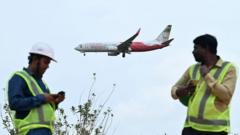India's aviation safety status is being scrutinized following a series of alarming incidents, most notably the tragic Air India crash of June, which resulted in the loss of at least 270 lives shortly after takeoff from Ahmedabad. With the volume of passenger air traffic having more than doubled since 2014-15, concerns about safety protocols and airline maintenance practices have come to the forefront.
Faiz Ahmed Kidwai, the chief of the Directorate General of Civil Aviation (DGCA), assured the public in a recent BBC interview that India's skies have always been safe. He referenced global safety metrics from the International Civil Aviation Organization (ICAO), indicating that India has consistently performed better than the worldwide average in terms of accidents per million flights, citing only two years from 2010 to 2024 where they exceeded global standards due to major accidents.
However, despite these assurances, there is growing unease following the Air India crash. It marks the third major aviation disaster in India over the past 15 years, including the Air India Express Flight 1344 crash in August 2020 and the 2010 Mangalore accident, which claimed 158 lives. These events have stoked public fears about aviation safety and prompted renewed scrutiny.
Recent reports have surfaced regarding operational challenges within airline companies. SpiceJet, for example, faced scrutiny after its De Havilland Q400 turboprops exhibited premature propeller failures—a case that was escalated to the DGCA after the airline allegedly did not address the root cause of the issue sufficiently. The regulator took action, demanding corrective measures and disciplinary action against management who failed to comply with safety regulations.
Further compounding concerns, Air India's budget carrier was reprimanded in March for delaying mandatory engine part replacements on an Airbus A320 and allegedly falsifying compliance records. Kidwai acknowledged that while such lapses are concerning, there is a silver lining in the improvement of reporting culture among airlines. Quantifying this shift, Indian domestic carriers reported nearly 2,500 technical faults since 2020—a statistic reflecting a growing willingness to address safety issues openly.
The saga of turbulence continued in May when an IndiGo flight from Delhi to Srinagar encountered severe weather, leading to a declared emergency upon landing. This incident prompted an investigation, resulting in pilot suspensions and a review of regulatory guidelines for operations in turbulent conditions.
The need for stringent oversight becomes crucial as the market expands rapidly, with scheduled carriers operating close to 850 aircraft—a marked increase from just around 400 a decade ago. The DGCA faces mounting pressure to ensure that safety protocols keep pace with this growth, particularly amidst budget cuts that reflect a reduced emphasis on civil aviation.
Despite the tragic incidents, Kidwai noted a stable pattern in air traffic, stating no significant drop in domestic or international travel post-crash. Instead, he suggested that initial anxieties would eventually subside as the industry adapts to the dynamics of the changing aviation landscape.
As India strives to maintain its reputation in an expanding aviation market, the balance between growing demand and ensuring safety will be paramount to the future of air travel within the nation.




















